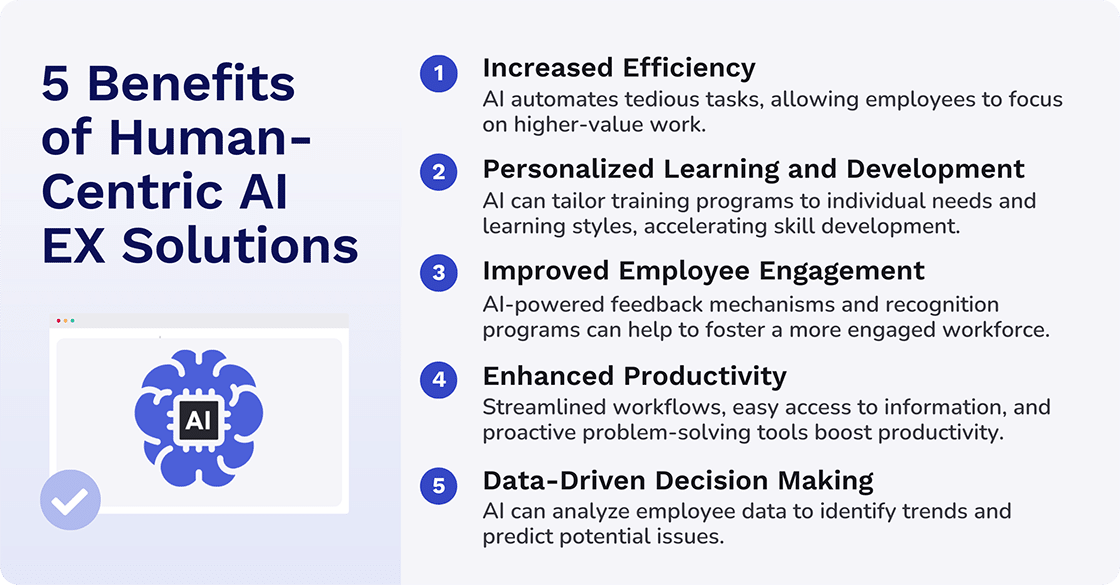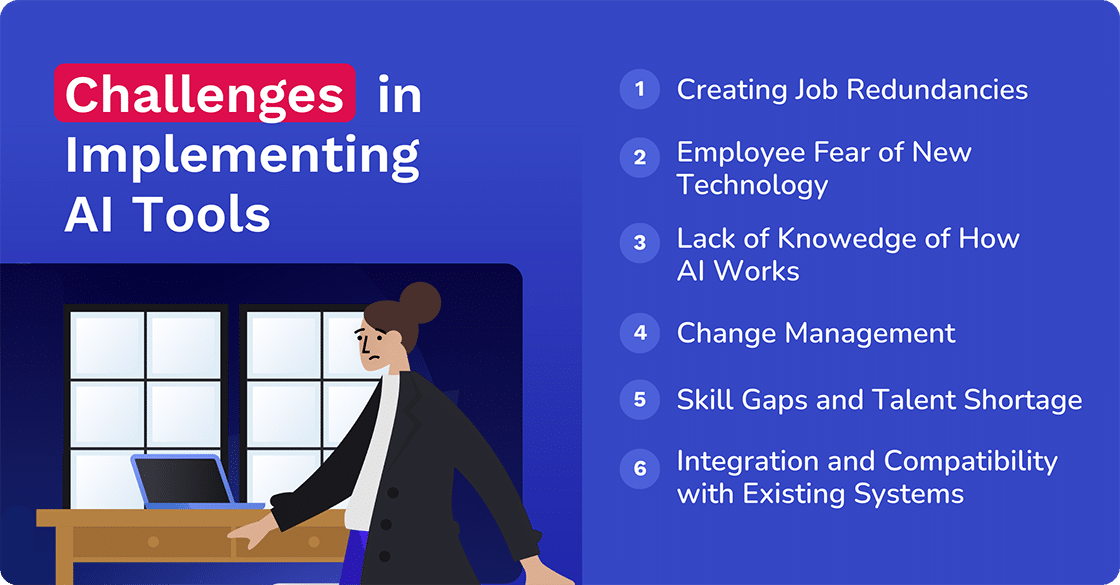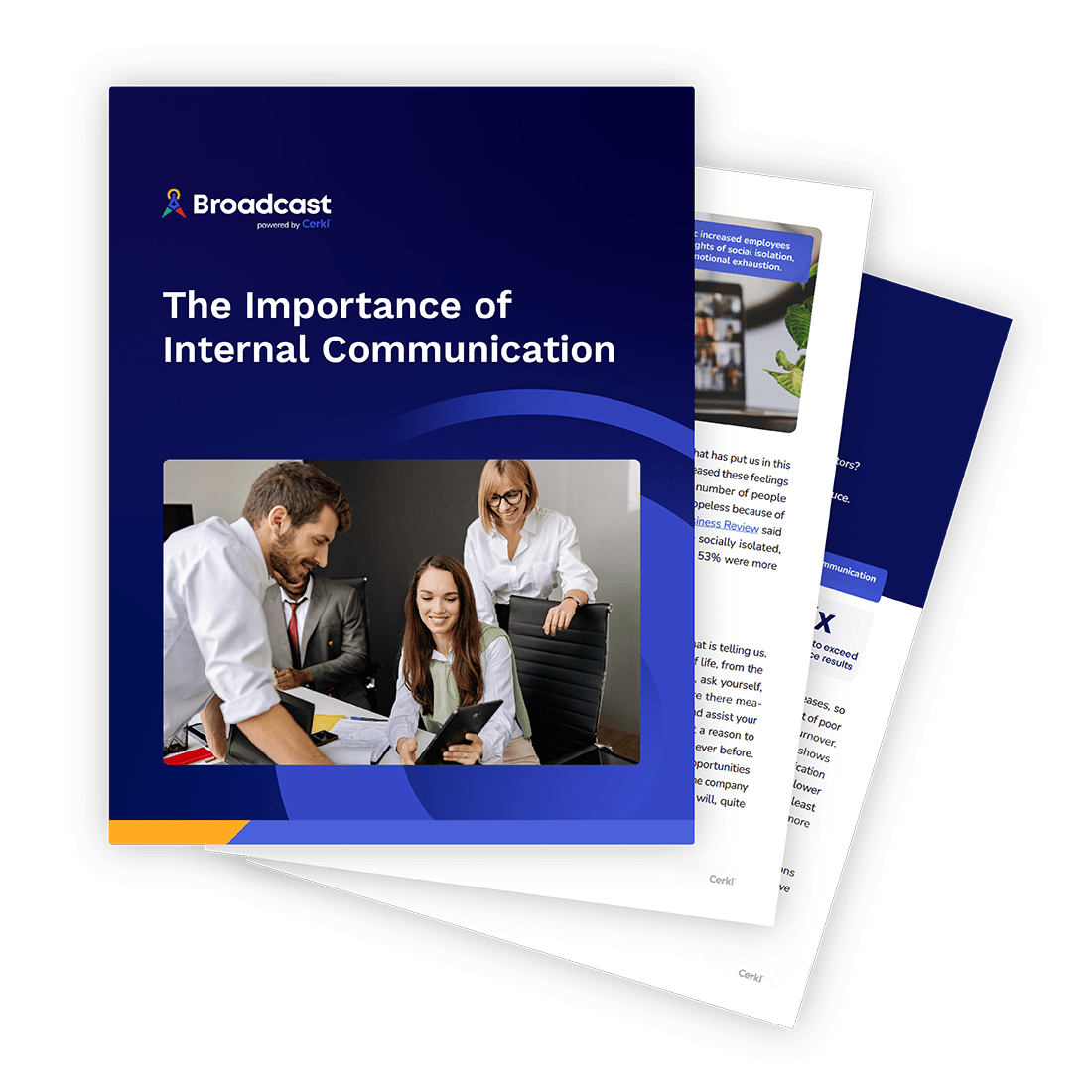You can revolutionize your workplace with an AI employee experience. Don’t get left behind, Find out how, right here.

.webp)
Effective internal communication is the backbone of every successful organization. Learn the ins and outs of internal communications with our research-backed white paper.
Access NowThe modern workplace prioritizes employee experience (EX) like never before. A positive EX fosters a happy, engaged workforce, which leads to increased productivity, innovation, and customer satisfaction. At the same time, artificial intelligence (AI) is emerging as a game-changer, offering a plethora of tools and solutions to help elevate employee experience.
AI is poised to revolutionize the modern workplace by personalizing EX, automating mundane tasks, and enhancing decision-making. By prioritizing the artificial intelligence employee experience (AI EX), organizations can improve employee well-being through monitoring and support. They can also streamline communication across teams and accelerate professional development by identifying skill gaps and recommending tailored learning opportunities.
There are multiple reports based on ongoing research that show the impact of AI in the workplace and on important factors like EX.
As an example, one research report, Zendesk EX Trends 2024, states that IT and HR leaders are leveraging AI-powered tools, both in training and in workflows. In this, their second annual employee experience trends report, they share that nearly 40% of these leaders indicated that they have many AI tools on offer. A further 35% say they’re “planning to expand their offerings.”
Cerkl has published many blog posts about EX and a fair number about AI. In this post, we’re extending our reach to the artificial intelligence employee experience (AI EX). We are going to explore its benefits, practical applications, and considerations for successful implementation. Let’s get started.
Turn your internal communications strategy around today

AI Employee Experience (or AI EX) refers to the process of integrating AI technologies to enhance all aspects of an employee's journey within a company. This encompasses everything from onboarding and training to performance management, communication, and access to information. By automating repetitive tasks, providing personalized support, and generating data-driven insights, AI EX empowers employees to focus on their strengths and contribute meaningfully, ultimately boosting employee engagement.
It might sound mind-bending, but it’s something that many companies are embracing, and have been for some time. And it works.
Qualtrics’ research, for example, shows that 65% of the C-suite were open to using AI versus 46% of managers. Sarah Marrs, who was then the Director of EX Strategy Execution at Qualtrics, said it was important to trust AI. This would help to make employees more productive and efficient in their jobs. In turn, organizations would be able to use AI for their benefit.

On the other hand, the report indicates that employees with low engagement, distrust in their organization, or concerns about job security are more likely to view AI negatively. This reinforces the common employee perception that AI's primary impact is job displacement.
“The more positive you feel about your organization, the more likely you are to believe that it will use AI for your benefit. You also trust that AI will make you more productive and efficient at your job.” Sarah Marrs
Here’s something that should make a lot of employees feel a whole lot more comfortable about AI solutions. Quite simply, a human-centric approach to AI in EX emphasizes collaboration and augmentation, not replacement.
Key benefits include:

According to the Deloitte 2023 Global Human Capital Trends Report: New fundamentals for a boundaryless world, 93% of business leaders surveyed believe that using technology to improve work outcomes and team performance is important or very important to their organization’s success. Only 22% believe that their organizations are ready to use technology to improve team performance and work outcomes. But 42% expect that technology is going to help drive better organizational outcomes. They believe that will happen quite simply by “nudging workers and teams to perform better.”
In 2023, IBM’s Institute for Business Value focused on executives’ perspectives on leadership and business, their changing roles and responsibilities, and CEO decision-making today. This included their use of technology, data, and metrics, as well as visions for the future. Statistics in their report, CEO decision-making in the age of AI are telling. For instance:
Turn your internal communications strategy around today

Implementing AI tools in the workplace can offer significant advantages, but it also comes with several challenges that organizations need to navigate. These are some of the key challenges:

Research by the World Economic Forum suggests that while AI can create new opportunities, it can also render certain roles redundant, requiring careful management of workforce transitions. A Forum Institutional article, We often hear that AI will take our jobs. But what jobs will it create? by Ian Shine adds perspective.
Quite simply, he says, “AI is expected to create new fields of work and lead to large expansion in others.” At the same time, change is inescapable.
“This inevitably means that old jobs disappear, but as creative destruction is powered by innovation, it also means that new jobs are created.” Ian Shine
They will also reshape certain job roles including:
However, they are not limited to these. For instance, there is evidence that there will be growth opportunities in areas like higher education teachers, university lecturers, and healthcare professionals.
On the other side of the coin, manual work that isn’t reliant on language-related tasks is unlikely to be impacted negatively by AI.
Nevertheless, an undeniable challenge is that many employees globally fear AI, some because they don’t understand its potential benefits. Others are convinced their jobs will soon be in jeopardy. That is one reason why AI EX is so crucially important.
An Ernst & Young Global Limited (trade name EY) report, How organizations can stop skyrocketing AI use from fueling anxiety reveals that employees want to know more about safe, responsible, and ethical AI use. Based on an October 2023 online survey among Americans with office or desk jobs, it states that 90% of respondents acknowledge that their organization is using at least one AI technology. GenAI tops the list (more than 50%), followed by chatbots and virtual assistants (more than 40% each).
The survey identified a mix of fears and positivity. For example:
“Armed with a deeper understanding of what is driving anxiety around AI, organizations can take the appropriate steps to work through workforce concerns and equip their people for today’s, and tomorrow’s, challenges.” EY
An AI-powered employee experience needs to be part of this strategy.
The good news is that you don't need a complete AI overhaul to begin. Here are some initial steps to get started with integrating AI EX into your organization.
Analyze employee feedback and surveys to pinpoint areas where AI can offer the most significant impact on employee experience.
Begin with a pilot program focusing on a specific area like onboarding or IT support to test the waters of AI EX.
Focus on user-friendly interfaces and ensure seamless integration with existing systems for a positive impact on AI EX.
Clearly communicate the purpose and benefits of AI to employees to address any concerns and ensure a smooth rollout of AI EX.
Invest in comprehensive training programs to equip employees with the necessary skills to use AI tools effectively.
Implement monitoring systems to evaluate the performance of AI tools and their impact on employee experience. Collect data on usage patterns, employee feedback, and efficiency improvements.
Address ethical concerns by ensuring transparency, fairness, and accountability in your AI implementations. Regularly audit AI systems for biases and ensure compliance with data privacy regulations.
Encourage a culture that embraces innovation and continuous improvement. Promote the benefits of AI and how it can enhance job roles rather than replace them.
Leverage AI-powered tools to streamline various processes and enhance overall efficiency. For instance, use AI for advanced analytics to gain deeper insights into employee behaviors and preferences, enabling more personalized and effective strategies.

Cerkl empowers organizations through Broadcast, its AI-powered platform. The company also constantly improves the software to enhance employee engagement, save time, provide personalized experiences, and enhance overall employee satisfaction.
Here are some ways Cerkl can boost AI Employee Experience in your organization.
By leveraging Cerkl's AI-driven solutions, organizations can significantly enhance their employee experience, leading to a more engaged and productive workforce.
Successful internal communication strategies play a vital role in employee engagement relationships. Our white paper on The Importance of Internal Communication focuses strongly on employee engagement. It identifies the negative effects of ineffective internal comms along with the opposite effects of excellents comms. It also shows why it is imperative to build positive relationships with employees to improve EX and increase productivity.

Turn your internal communications strategy around today
How is AI used in employee experience? AI is used in employee experience to automate tasks, personalize employee interactions, provide data-driven insights for improving processes, and offer AI-powered tools for communication and collaboration.
What are the positive impacts of AI in the workplace? AI positively impacts the workplace by increasing efficiency, enhancing decision-making, improving employee satisfaction through personalized experiences, and freeing up employees to focus on higher-level tasks.
How do employees feel about AI? Employees generally view AI as a tool that can improve work efficiency. However, many people harbor concerns about job security and potential biases in AI systems. It’s a challenge for organizations in general.

Turn your internal communications strategy around today